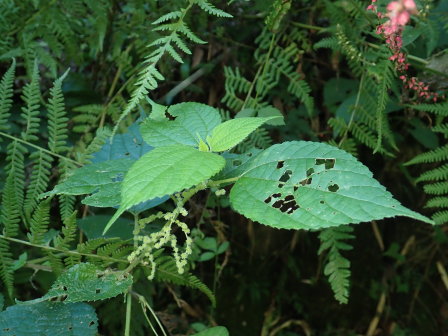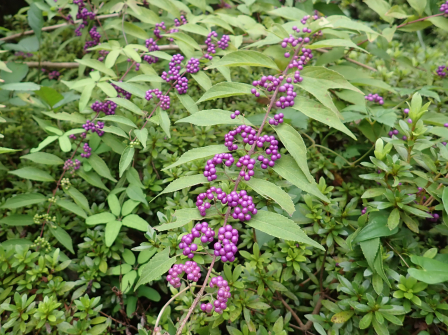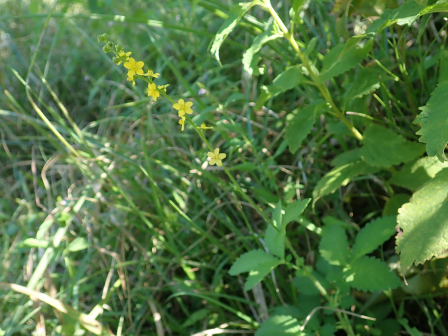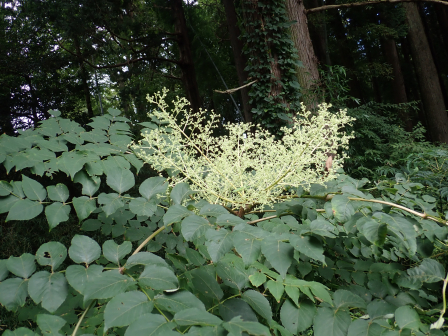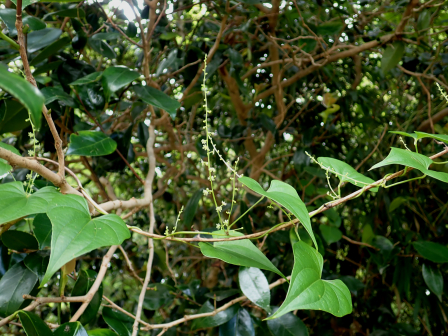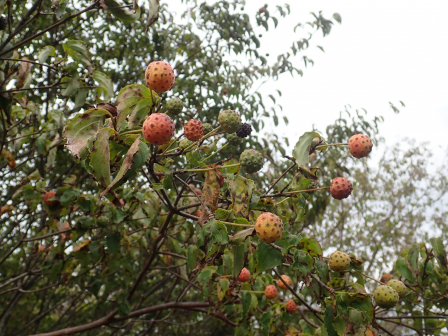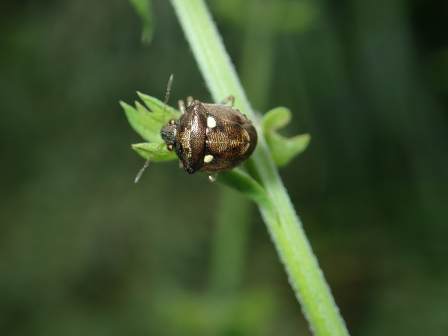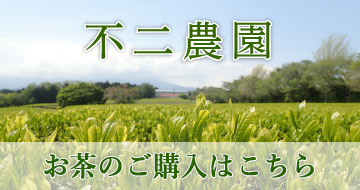フィールド日記
2021年09月
2021.09.28
カラムシ
裏道でカラムシの花が咲いていました。写真に写っているのは雌花序で、球状に集まった雌花が、穂状についています。林縁や空き地などによく見られる植物で、かつては繊維をとるために利用されました。
"Karamushi (カラムシ)" plants are in bloom on the back road. The inflorescence in the photo is a female one, which is female flowers form spheres hanging on spikes like branches. They are often seen in forest edges and vacant lands. In the past, they were used as a material to get fibers.
2021.09.24
コムラサキ
校舎の近くのコムラサキの果実が紫に色づいています。ムラサキシキブに似ていますが、樹高が低く、紫の果実がより密につくという特徴があります。植物としては別種ですが、園芸的にはコムラサキもムラサキシキブと呼ばれることもあります。
Fruit of "Ko-Murasaki (コムラサキ)" trees by the school building is turning purple. They are similar to a relative species "Murasaki-Shikibu (ムラサキシキブ)", but "Ko-Murasaki (コムラサキ)" trees are shorter and bear their purple fruit more densely than "Murasaki-Shikibu (ムラサキシキブ)" trees. "Ko-Murasaki (コムラサキ)" and "Murasaki-Shikibu (ムラサキシキブ)" are different species, but in gardening, both of them can be called "Murasaki-Shikibu (ムラサキシキブ)".
2021.09.21
キンミズヒキ
ススキ野原でキンミズヒキが咲いています。和名は、タデ科のミズヒキに花の付き方が似ていることに由来します。しかし、キンミズヒキはバラ科で、植物としては別のグループに属しています。
"Kin-Mizuhiki (キンミズヒキ)" plants are in bloom in the Japanese pampas grass field. The name comes from the fact that the way they bloom looks like the plant "Mizuhiki (ミズヒキ)", witch belongs to the "Knotweed" group. However, "Kin-Mizuhiki (キンミズヒキ)" plants belong to the "Rose" group, witch has different characteristics from those of the the "Knotweed" group.
2021.09.17
タラノキ
駐車場の近くでタラノキの花が咲いていました。山菜として有名なタラノメは、本種の若芽です。タラノキは先駆樹種といわれ、伐採跡地などにいち早く侵入して生長します。
"Taranoki (タラノキ)" trees are in bloom near the parking area. "Taranome (タラノメ) ", which is famous as a wild edible plant, is a young bud of this species. "Taranoki (タラノキ)" trees are the first plants to colonize cut-over areas, which is called "pioneer tree".
2021.09.14
オニドコロ
駐車場近くでオニドコロが咲いていました。植え込みなど、身近なところでもよく見られるつる植物です。近縁のヤマノイモと似ていますが、つるの巻く方向が逆向きです。また写真のように雄花の花序が立ち上がることは、近縁のヒメドコロと見分ける特徴になります。
"Oni-Dokoro (オニドコロ)" plants are in bloom near the parking area. They are vine plants that are often seen in common places like bushes. The way their vines twine is opposite directions compared to their relative species "Yamanoimo (ヤマノイモ)". As you can see in the photo, you can tell them from other relative species "Hime-Dokoro (ヒメドコロ)" by the fact that their spikes of male flowers grow straight up.
2021.09.10
ヤマボウシ
プール横のヤマボウシの果実が赤く色づいていました。果実は甘く食用になります。果実は複合果(または多花果や集合果とも)と呼ばれ、複数の花の果実が集まってくっつき、1つの球形の果実をつくっています。(ヤマボウシの花のようすはこちら)
"Yamaboushi (ヤマボウシ)" fruits by the school pool are turning red. The fruits are sweet and edible. Each sphere is formed from multiple flowers, which is called "multiple fruit". (Click here to read an article about flowers of "Yamaboushi").
2021.09.07
ムラサキシラホシカメムシ
ムラサキシラホシカメムシを見つけました。草むらなどでよく見かける5㎜ほどの小さなカメムシです。キク科やマメ科、イネ科など様々な植物につきます。この個体はシソ科の植物についていました。似た仲間が何種かいますが、本種は光沢があり、二つの白い紋が他種に比べ大きいという特徴があります。
I found a stink bug called "Murasaki-Shirahoshi-Kamemushi (ムラサキシラホシカメムシ)". They are about 5 mm in length and often seen in grassy places. They eat wide variety of plants such as those of composite family, pea family and grass family. This sting bug was seen on a plant of mint family. There are some similar species to this one. This species is shiny and their two white spots are larger than the other ones.
2021.09.03
ヒメカタホコリ
裏道でヒメカタホコリと思われる変形菌を見つけました。大きさは1.5mmほどで、白色の石灰の結晶で覆われた球形の部分に胞子が入っています。大型のアメーバ状の変形体が成熟すると、一晩で写真の子実体と呼ばれる構造に変化します。
I found slime molds that look like "Hime-Katahokori" on the back road. They are 1.5 mm in height and there are their spores in the spheres covered with white lime crystals. Their large ripe amoeba-like bodies change to the structure called "fruiting body" just in one night, which you can see in the photo.
- 1 / 1


